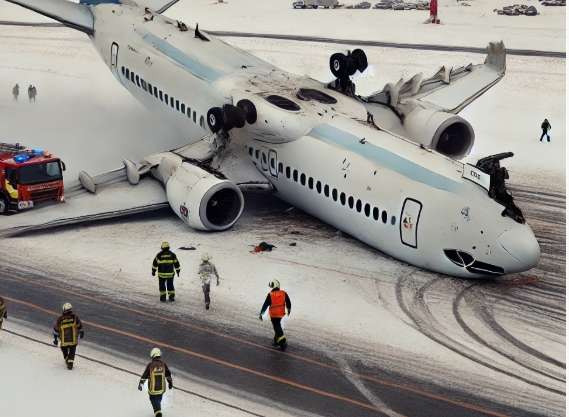Delta Crash Investigators Baffled by Missing Right Wing.
The remarkable survival of all 80 passengers and crew aboard Delta Air Lines Flight 548 after a dramatic crash landing at Toronto’s Pearson International Airport on Monday, March 11, 2024, underscores the critical importance of aviation safety protocols and passenger preparedness. The incident, reminiscent of a previous mishap at the same airport in 2005 involving an Air France Airbus A340, fortunately resulted in only minor injuries despite the aircraft, a Mitsubishi CRJ-900LR, flipping onto its roof and catching fire. The scene, captured in social media videos and described by witnesses as the plane being “upside down and burning,” belied the fortunate outcome, with passengers calmly evacuating the overturned fuselage assisted by emergency responders.
While the official investigation is still underway, led by the Canadian Transportation Safety Board with assistance from U.S. authorities, preliminary reports point to a combination of factors potentially contributing to the accident. The flight, originating from Minneapolis, encountered snowy and windy conditions upon its attempted landing. Although communication between the pilot and air traffic control seemed normal, and the runway was reported as dry with no crosswind at the time of touchdown, something went awry, causing the aircraft to lose control and flip. Meteorological reports indicated gusting winds up to 65 kph and temperatures around 16.5°F, with air traffic controllers having warned the pilots of potential turbulence. However, the CRJ-900 is designed to handle such conditions, making the accident unusual and raising questions about the exact sequence of events.
A crucial element under investigation is the missing right wing of the aircraft, which could have played a significant role in the rollover. Investigators are meticulously analyzing the flight data recorder and cockpit voice recorder, seeking insights into the actions taken by the pilots and any mechanical issues that might have contributed to the wing’s detachment. Experts will also be scrutinizing the aircraft’s maintenance records and the overall operational procedures of Endeavor Air, the Delta subsidiary operating the CRJ-900. The investigation will likely explore whether factors such as icing on the wings, a sudden wind shear, or pilot error contributed to the unusual chain of events.
The swift and efficient response of emergency teams at Pearson Airport played a crucial role in minimizing injuries and preventing fatalities. Firefighters promptly extinguished the fire, while paramedics and other emergency personnel quickly attended to the passengers and crew. Eighteen passengers, including one child, were transported to hospitals for further evaluation, with the majority of individuals escaping with only minor injuries. This efficient emergency response, described by Pearson Fire Chief Todd Aitken as “going as planned,” highlighted the importance of well-coordinated airport emergency protocols and the effectiveness of first responder training.
While official reports have not explicitly highlighted the role of seatbelts, the fact that all 80 people on board survived with only minor injuries strongly suggests that their use played a significant part in mitigating the impact of the crash. Standard aviation safety procedures mandate the use of seatbelts during takeoff and landing, a practice that would have prevented passengers from being thrown around inside the cabin during the violent rollover. This incident serves as a powerful reminder of the importance of adhering to safety regulations and the potentially life-saving benefit of wearing seatbelts throughout the flight.
This accident marks the fourth major aviation incident in North America within a three-week period, a concerning trend that raises questions about air safety and prompts renewed scrutiny of regulatory oversight and airline operating procedures. These incidents, including a deadly midair collision near Washington, D.C., a medical plane crash in Philadelphia, and a crash in Alaska, collectively resulted in significant loss of life. While each incident presents unique circumstances, their occurrence within such a short timeframe necessitates a thorough review of systemic factors and the implementation of any necessary corrective measures to enhance aviation safety. The investigation into the Delta crash at Pearson Airport will undoubtedly contribute to this broader analysis, providing valuable insights for preventing similar occurrences in the future. The cooperation between Canadian and U.S. authorities in this investigation emphasizes the importance of international collaboration in addressing aviation safety concerns and ensuring the well-being of passengers and crew.
Share this content:












Post Comment